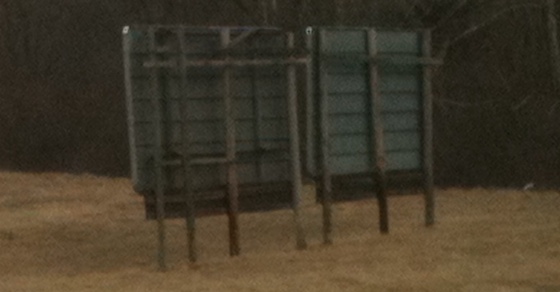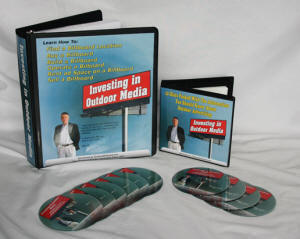Memo From Frank
What is a billboard worth? I get that call all the time. Valuing a billboard is simply a matter of math, but there are so many variables that the formula is not that cut-and-dried. At its most basic, a billboard is valued just like an income property; a rate of return is applied to the net income. The typical capitalization rate, or “cap rate”, on billboards ranges from 10% (with big companies) to 20% (for everyone else). So a billboard that has a net income of $10,000 per year, based on a 20% cap rate, would be worth $50,000. But it’s not that simple. To truly figure out the value you have to look at what the sign could rent for (not just what it currently rents for) as well as what an appropriate amount of vacancy would be, and also factor in intangible factors such as the growth of the market, the potential increase (or decrease) of traffic on the highway, and 101 other important items. I think that the best way to value a sign is as a range of values, from low to high. Then see if you can financially survive the worst case, and if the best and realistic case makes that risk worthwhile. Never get involved in a billboard that you cannot survive the worst case scenario on. If you are looking at a digital billboard that costs $1 million – and you cannot afford to lose $1 million – then avoid that deal. If, however, you are looking at a billboard that costs $30,000, and in the worst case scenario would be worth $15,000 in steel scrap, then that might be O.K. Big operators are survivors, who know how to mitigate risk, not wild risk takers, betting the farm on every acquisition. Follow their lead.
Why Some Signs Are One-Sided, And What You Can Do About It

The history of one-sidedness
Back in the old days, when billboards were not nearly as valuable and rents were a fraction of what they are today, the typical billboard was one-sided and faced the traffic heading into town only, and normally in the format of a right-hand read. Why not? Since there was no control of billboards before the National Beautification Act in 1968, you could build a billboard virtually anywhere, so there was no reason to build a back-side on a structure – only the A side could find an advertiser.
The missed opportunity
Of course, a quick review of economics would have shown that not having a second side was very inefficient. If you already have the billboard structure, the costs are predominantly fixed (ground rent, taxes, insurance, etc.) so the second side is nearly straight profit. But in the early days, people were not as sophisticated on financials and EBITDA and all. But there’s no question that, when a second side is visible, every structure should have two, rather than one, sides.
The impact of grandfathering
So why doesn’t every billboard owner just go throw a second side on their sign? The reason is “grandfathering”. When you build a billboard, and they later change the ordinance such that you could not build a new billboard on that same location, the billboard becomes “grandfathered” – which means that you are not allowed to alter it in any way, including building a second side to it. So, while there are many billboards in which the owner would like to add that second face, they simply cannot. And that also means that the original owner of the sign’s mistake in not adding that second side was a permanently bad idea.
The opportunity in legal-conforming status
There are, however, situations in which the second side of the billboard is feasible. These signs, which still allow for adding on, are called “legal conforming” locations. With a “legal conforming” location, all you have to do to add on that second face would be to get a permit from the city and/or state, revise the engineering, and get it up there.
The premise sign option
Another opportunity, that few people realize, is to add a second side on a premise sign that exists under a billboard permit. Here’s the example of how I did this in Terrell, Texas. There was a single-sided billboard for Knox Fuel Stop on Interstate 20. Knox owned the sign, and used it to direct traffic to its exit. But they are not a billboard company, and did not look to the sign as a source of revenue. So we approached Knox about adding an east-bound face to the sign, going away from their exit. Since they had no use for a billboard going the wrong direction, they agreed to a rent of $50 per month for the back side. We build the sign face and rented it out for $400 per month. There was no big upfront cost, as all we had to do to add a second side was nail up some panels and wrap it in vinyl.
Conclusion
All billboards should have a second side – it makes complete economic sense. However, not all billboards are able to take advantage of this opportunity today, due to changes in the ordinances. Watch for these opportunities, and if you are building a new sign, definitely think in terms of two and not one.
Henry Ford Would Have Been A Great Billboard Salesman
I can’t emphasize enough that the difference between success and failure is often mental attitude. During the Civil War, successful generals knew that they had a better chance of winning if they had their troops run, screaming, at the enemy. What they were trying to accomplish was to create (or at least pretend to create in the eyes of the enemy) the quality known as “enthusiasm”. When you are enthusiastic, you have that additional edge of fighting harder and more persistently. People react well to enthusiasm, as if you believe in your product, it gets contagious. Henry Ford, who virtually invented and dominated the American car industry said “You can do anything if you have enthusiasm. Enthusiasm is the yeast that makes your hopes rise to the stars. With it, there is accomplishment. Without it, there are only alibis.” So when you are out renting billboard space – of even finding new billboard locations to build – make sure that you do it with enthusiasm, to give you the winning edge.
Billboard Home Study Course
![]() How to Find a Billboard Location
How to Find a Billboard Location
![]() How to Buy a Billboard
How to Buy a Billboard
![]() How to Build a Billboard
How to Build a Billboard
![]() How to Operate a Billboard
How to Operate a Billboard
![]() How to Rent Ad Space on a Billboard
How to Rent Ad Space on a Billboard
![]() How to Sell a Billboard
How to Sell a Billboard
Get Your Copy Now!
The Market Report
Prices Are Delayed By At Least 15 Minutes
